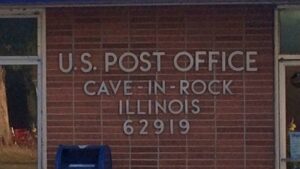After wandering around New Harmony, Indiana, for a while and seeing many interesting things, it occurred to me that we hadn’t visited one of the places that I was curious to see, because I didn’t know exactly where to find it.
Google Maps in this instance didn’t know either. Or rather, I didn’t know exactly what the spot was called, to tell Google. The search engine isn’t a mind reader, not yet (but surely that’s Alphabet Inc.’s dream).
We spent time looking around an antique and knickknack store on the main street, since New Harmony, pop. 750, has some of the elements of a day-trippers town (like Fredericksburg, Texas). I found a candle holder I wanted to give as a gift, and after paying for it, I asked the woman behind the counter two questions.
One, where I might find postcards, since her store had none. She offered a suggestion, and another customer who had overheard us offered another suggestion, which turned out to be closer by and correct.
My other question: “Can you tell me where I can find Paul Tillich’s grave?” I’d read it was in town. Not in a cemetery, but a standalone location.
I can’t claim to be an expert on Paul Tillich, or even remember that much about him or his theological ideas. Whatever I might have learned during my collegiate religious studies had long been forgotten. Still, I figured I should drop by and pay my respects, and later do a little reading to refresh my memory.
She told me where to find him. We’d wandered by previously without realizing it, since he’s tucked in a grove of conifers forming Paul Tillich Park.
 None of the stones in the pictures are his gravestone. Rather, they’re some stones in the park with Tillich’s words carved on them.
None of the stones in the pictures are his gravestone. Rather, they’re some stones in the park with Tillich’s words carved on them.

This is his stone.

A little hard to read, even when you’re standing in front of it. Turns out to be Psalm 1:3.
PAUL JOHANNES TILLICH
1886-1965
And he shall be like a tree planted by the rivers of water, that bringeth forth his fruit for his season; his leaf also shall not wither; and whatsoever he doeth shall prosper.
What’s Tillich doing in Indiana? Broadly speaking, he was another inadvertent gift to the United States from the Nazis, like Einstein or Thomas Mann or Billy Wilder or Walter Gropius. Tillich came to America in 1933 and held a number of academic posts in this country. Apparently he was taken with the history and setting of New Harmony.
“Before his death in 1965, the philosopher Paul Tillich hoped to make New Harmony a center for his own teachings, and thus in a way fulfill the early ambitions of Rapp and Owen in making the town an example of spiritual and material concerns successfully united,” notes a 1978 New York Times article, which is worth reading all the way through. “The trust created Paul Tillich Park…”
Jane Blaffer Owen’s trust, that is, mentioned yesterday.
“Jane Owen’s charisma emanated from her spiritual liberality [also, maybe, her largesse]. She was profoundly affected by the teaching of the twentieth-century German-American theologian Paul Tillich, becoming by turns his admirer, student, and friend….” writes Stephen Fox in a magazine published by Rice University — also worth reading all the way through.
“In 1963, she persuaded Tillich to come to New Harmony to dedicate a site across Main Street from the Roofless Church for a park to be named in his honor.”
“On [Philip] Johnson’s recommendation, she had the New York landscape architects Zion & Breen design a natural setting of grassless berms planted thickly with spruce and hemlock trees, around which granite boulders inscribed with passages from Tillich’s writings and a bronze bust by James Rosati were installed. This is where Tillich’s ashes were interred in 1966.”
We weren’t quite finished with New Harmony after visiting Tillich. We spent some time at the town’s labyrinth, formally the Cathedral Labyrinth and Sacred Garden and patterned after one in Chartres Cathedral. Another work of the Robert Lee Blaffer Foundation.

We spent some time walking it. Ann had more patience with it than I did.
Finally, we approached the Harmonist Cemetery, or the Rappite Cemetery, a burying ground surrounded by a low wall. Outside the wall are an assortment of well-worn stones, dating from the 19th century but after the utopian experiments in New Harmony.

Many are illegible, but I could read the names and much of the info on this one.

JANE
Consort of
JOHN T. HUGO
Died March 11, 1846
Aged 27 years, __ months and 10 days.
“Consort” isn’t a word I’ve seen too much in cemeteries, but maybe I don’t go to the right ones.
Behind the wall are no stones, just a wide expanse of grassy ground.

There was nothing on site to explain that, but after a moment’s thought we speculated that the Harmonists didn’t believe in individual gravesites or markers, so we were looking at a mass grave. Later I checked, and that’s correct. Ann said that made the site unsettling, and I suppose mass graves can be, say if mass violence was involved. I don’t think that was the case for the Harmonists; just the result of the everyday dangers of living in the 19th-century frontier.
Note also the mounds. Apparently the area was home to Indian mounds before the Harmonists came, and so they must have considered it a natural for a burial ground. About 230 of the colonists lie there.


























































































